In March 2022, the Federal Aviation Administration (FAA) released the long-awaited update to its Advisory Circular (AC) 150/5300-13B, Airport Design, providing new guidelines and recommendations for the geometric layout and design of runways, taxiways, aprons, and other facilities at civil airports.
The updated AC outlines the standards that airport planners and engineers follow when completing comprehensive master plans and construction projects. This latest version offers clearer and more detailed standards and guidelines and is a significant update from the previous version, which had not undergone any substantial revisions since 2014.
Over the last year, our airport planners and engineers have been implementing the changes in standards and guidance into our project plans and designs. We’ve communicated with the FAA on best practices of implementing the new guidance, specifically re-evaluating plans and designs initiated under the previous design AC to make timely updates reflecting new guidance. As a result of these comprehensive efforts, we have identified five highlights from the AC update that outline the best practices, design considerations, and requirements that we believe will have the most impact on your airport projects and long-term plans.
Standards, recommended practices, and requirements
Before diving into the details, it is important to share how the FAA now organizes design standards and recommended practices. This major change allows airports to assess the guidelines more effectively and choose design standards that suit their specific requirements while maintaining an acceptable level of safety, efficiency, and capacity during airport projects and modifications.
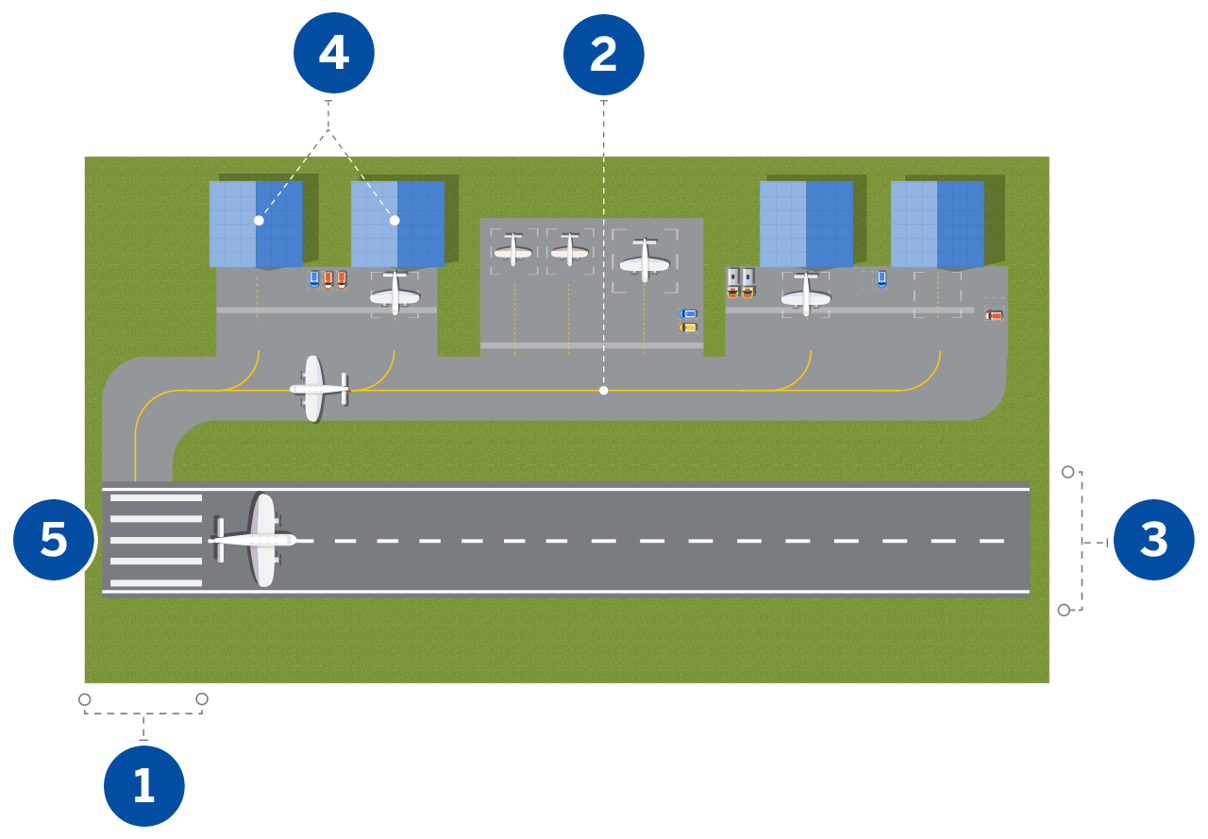
Five Key Highlights
- (1) Diverse Aeronautical Activities – Addresses the Runway Safety Area (RSA) and the FAA's prohibition on considering grass areas adjacent to runways for takeoff and landing purposes. The AC update provides better guidance to general aviation airports on how to address RSA activities when considering construction and planning projects.
- (2) Taxiway Design Standards – Uncovers how the Airplane Design Group (ADG) and Taxiway Design Group (TDG) dictate the required Object Free Area (OFA) and how taxiway pavement should be designed, including taxiway width, fillets, and the radius of the taxiway centerline.
- (3) Runway Design Standards – Changes to runway design standards for larger commercial aircraft with Runway Design Code (RDC) of C/D/E-III, and reduced pavement widths for lighter group C/D/E-III aircraft, offers potential cost savings in your next project. Early coordination with the FAA is important to discuss funding eligibility for runway rehabilitation and reconstruction projects where widths have been reduced.
- (4) General Aviation Facilities Appendix – Provides guidance for tiedown layouts based on aircraft size and an expanded section on hangar design covers six elements, including regulations, size, location, utilities, and door types, to enable general aviation facilities to optimize space and construct hangars that provide long-term benefits.
- (5) Terminal Instrument Procedures (TERPS) Surfaces – Includes changes to create new Obstacle Clearance Surfaces (OCS) and provides clearer guidance on which surfaces to implement for different types of runway approach procedures, including less restrictive instrument departure surfaces with steeper slopes in the outer wings to reduce impact close to runway thresholds.
1: Diverse Aeronautical Activities
The FAA recognizes that certain aircraft use grass areas adjacent to runways, but the RSA is designed to improve aircraft safety in the event of an overrun, undershoot, or veer-off. The FAA prohibits airport designers from considering these operations for takeoff and landing purposes, as it could introduce additional hazards.
While the old design standards briefly mentioned certain operations that took place off the side of the paved runway, the new FAA Design AC provides several pages of comprehensive guidance on these types of operations. It now acknowledges that pilots of certain aircraft, including ultralights, powered-parachutes, helicopters, gliders, agricultural aircraft, tailwheels, and aircraft with large balloon type "tundra" tires, occasionally use the unpaved portion of the RSA adjacent to a runway for takeoffs, landings, or other operations like banner towing.
If an airport experiences takeoffs and landings in RSA areas, it should coordinate with the Flight Standards District Office to conduct a safety assessment of the RSA. The airport is obligated by grant assurances to maintain a safe and serviceable RSA.
In addition, the airport sponsor should verify the required separation from the holding position of the adjacent runway and regularly inspect and maintain the RSA to ensure safe use for aircraft operations.
2: Taxiway Design Standards
Taxiway design standards are based on the specific pavement areas the aircraft is currently using or expected to use. The ADG defines the required OFA of taxiways and taxi lanes based on the wingspan of the critical aircraft, while the TDG determines taxiway pavement design, including width, fillets, and the radius of the taxiway centerline, based on the landing gear configuration of the critical aircraft.
To allow for new development, except for safety areas for the smallest ADG aircraft, the Taxiway Object Free Area (TOFA) and Taxilane Object Free Area (TLOFA) standards were reduced, with larger reductions for aircraft with larger wingspans. The reduction in OFAs was based on an FAA study that found large aircraft do not drift off the centerline as much as previously thought.
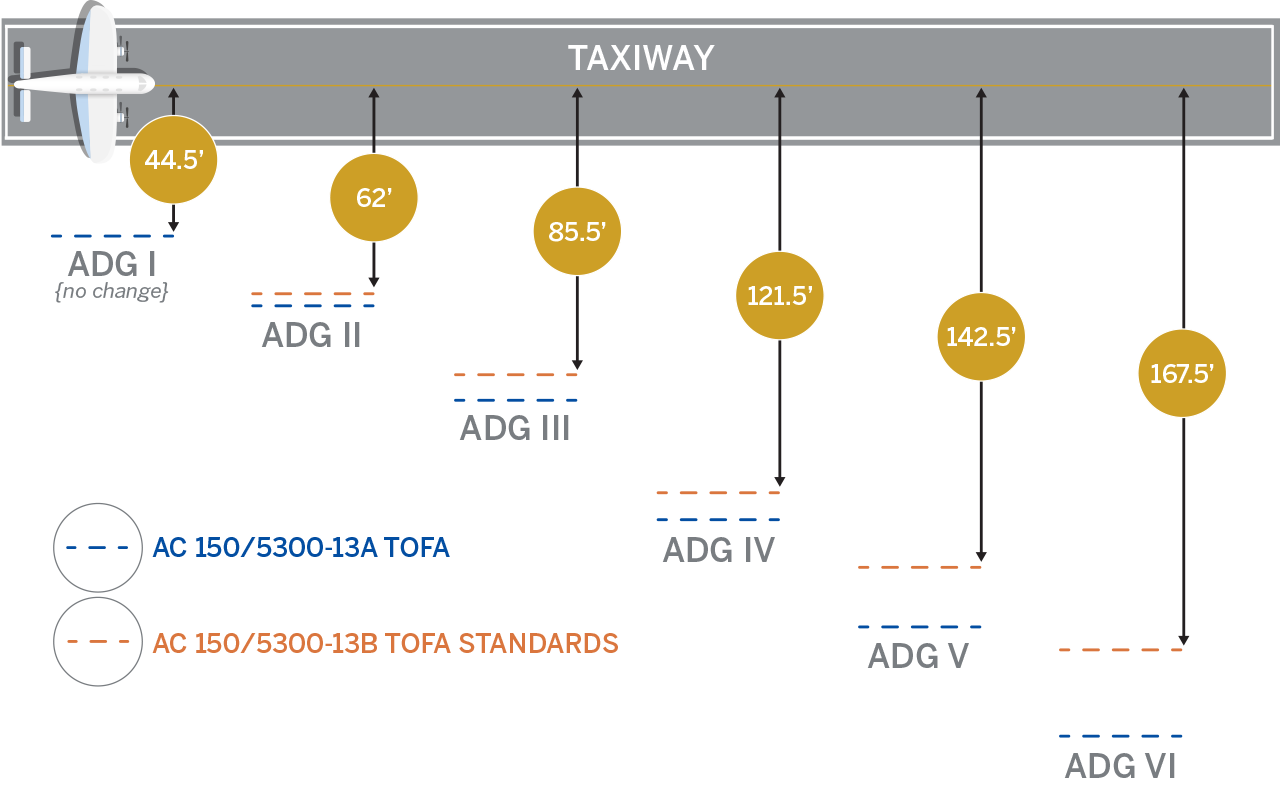 Graphic showing the difference in TOFA standards for different ADGs – a similar reduction in OFA widths was also seen for taxilanes.
Graphic showing the difference in TOFA standards for different ADGs – a similar reduction in OFA widths was also seen for taxilanes.
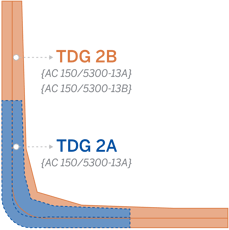 The TDG fillet design also changed in the new AC update. In the past, the TDG fillets were classified into seven groups, namely 1A, 1B, and 2 through 7. However, the updated AC now divides TDG 2 into two groups, 2A and 2B, based on aircraft dimensions and movements. Many general aviation airports are required to comply with either the 1A, 1B, 2A, or 2B TDG fillet standards. The 1A and 1B standards did not change; however, with the split of the 2A and 2B standards, there was a significant reduction in overall pavement from the TDG 2 standards to TDG 2A standards. Meanwhile, the total pavement for TDG 1B fillets increased slightly compared to the previous AC design standards.
The TDG fillet design also changed in the new AC update. In the past, the TDG fillets were classified into seven groups, namely 1A, 1B, and 2 through 7. However, the updated AC now divides TDG 2 into two groups, 2A and 2B, based on aircraft dimensions and movements. Many general aviation airports are required to comply with either the 1A, 1B, 2A, or 2B TDG fillet standards. The 1A and 1B standards did not change; however, with the split of the 2A and 2B standards, there was a significant reduction in overall pavement from the TDG 2 standards to TDG 2A standards. Meanwhile, the total pavement for TDG 1B fillets increased slightly compared to the previous AC design standards.
There were several changes made to taxiway design, including the implementation of a minimum angle for aircraft to approach the hold-short line when taxiing towards the runway. Another recommended practice, if space allows, is the construction of a taxiway offset at the runway end to mitigate wrong surface landings, facilitate a perpendicular aircraft holding position, and avoid existing NAVAIDs.
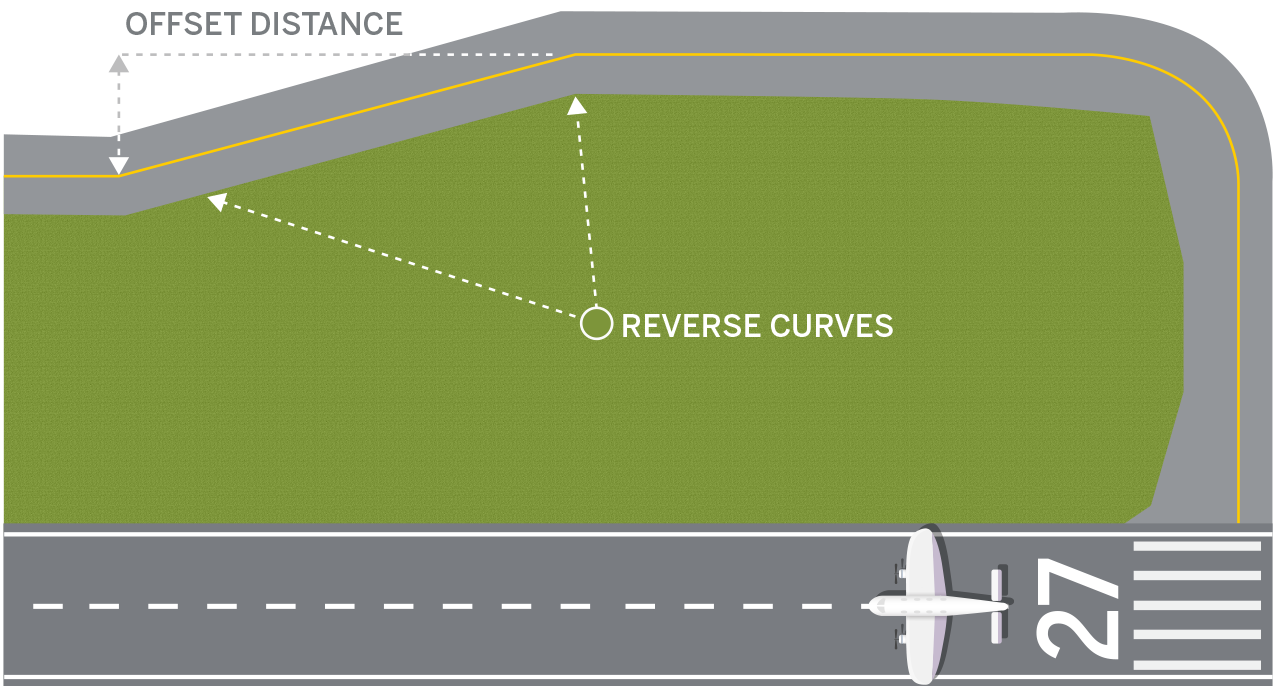
Source: FAA Advisory Circular 150/5300-13B, Airport Design
3: Runway Design Standards
The updated AC includes changes to runway design standards for larger commuter-type and commercial service aircraft with a RDC of C/D/E-III, typically found at commercial service airports.
The runway width, shoulder width, and blast pad width have been reduced for group C/D/E-III aircraft with a maximum certified takeoff weight (MTOW) of 150,000 pounds or less. This reduction in pavement widths for lighter aircraft could result in cost savings for the next runway reconstruction project.
It is important to coordinate early with the FAA to discuss funding eligibility for runway rehabilitation and reconstruction projects where widths have been reduced.
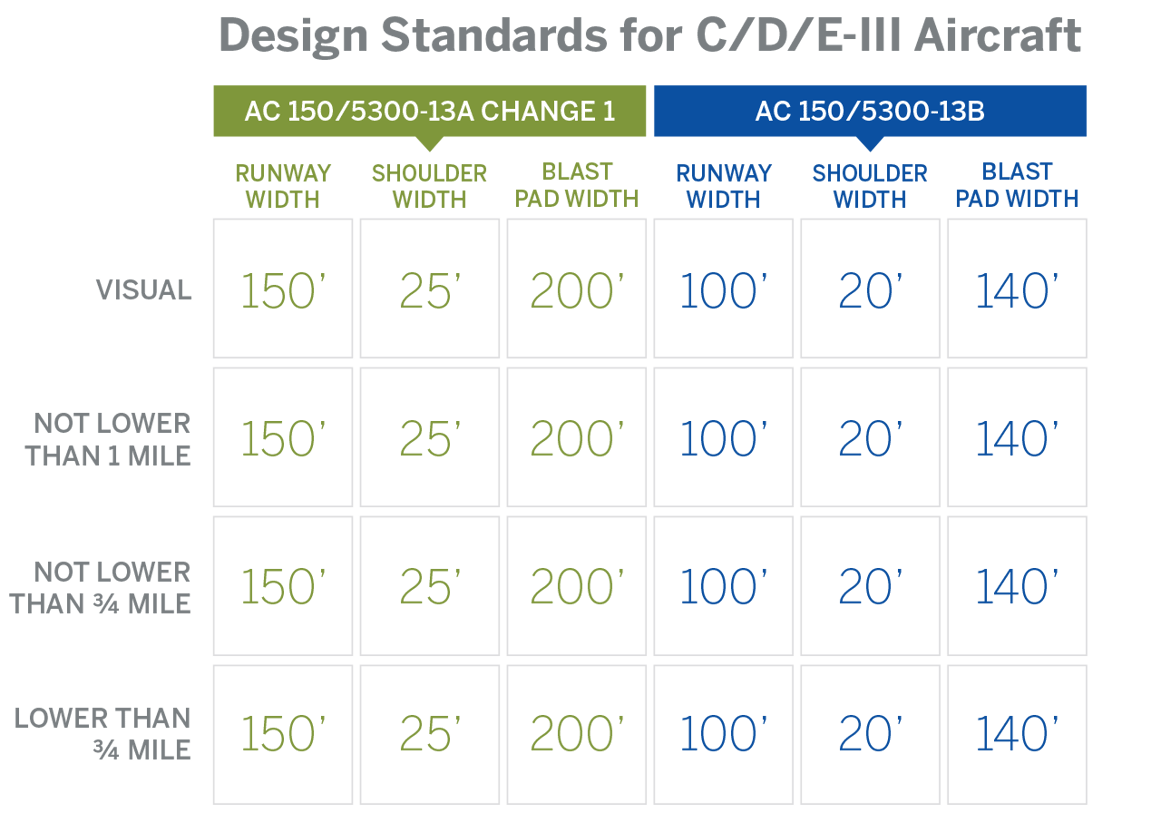
4: General Aviation Facilities Appendix
The General Aviation Facilities Appendix provides guidance on aircraft tiedown and hangar design.
Aircraft tiedown sizing
The FAA's new guidance and recommended practices for tiedown layouts are designed to help general aviation facilities optimize space and functionality on the apron. Grouping aircraft by size ensures adequate tiedown space, while grouping tiedown areas by different widths and lengths of aircraft allows for maneuverability and consistency throughout the apron area.
The recommended tiedown areas for aircraft are as follows:
- ADG I Aircraft: 30-45 ft. in length
- ADG II Aircraft: 60-90 feet in length (60, 75, and 90 ft.)
- ADG III Aircraft: 100-115 ft. in length
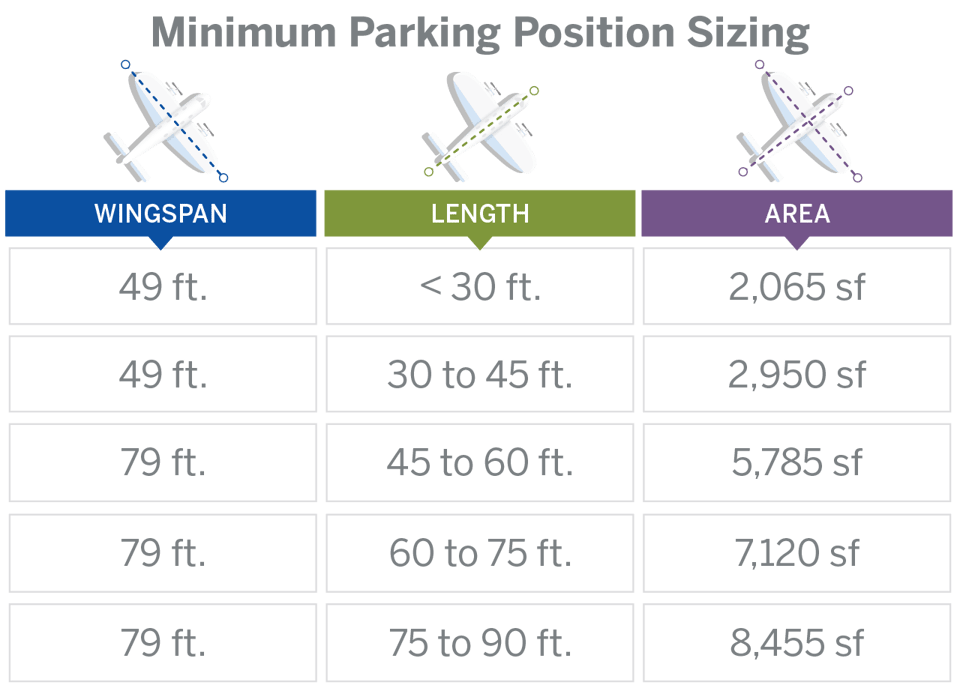 Note 1: Values for area are calculated by multiplying the sum of the wingspan dimension plus 10 feet (3 m) by the sum of the maximum aircraft length plus 5 feet (1.5 m) and rounding up to the nearest multiple of 5.
Note 1: Values for area are calculated by multiplying the sum of the wingspan dimension plus 10 feet (3 m) by the sum of the maximum aircraft length plus 5 feet (1.5 m) and rounding up to the nearest multiple of 5.
Note 2: Values for area do not include the TLOFA in front of the parking position.
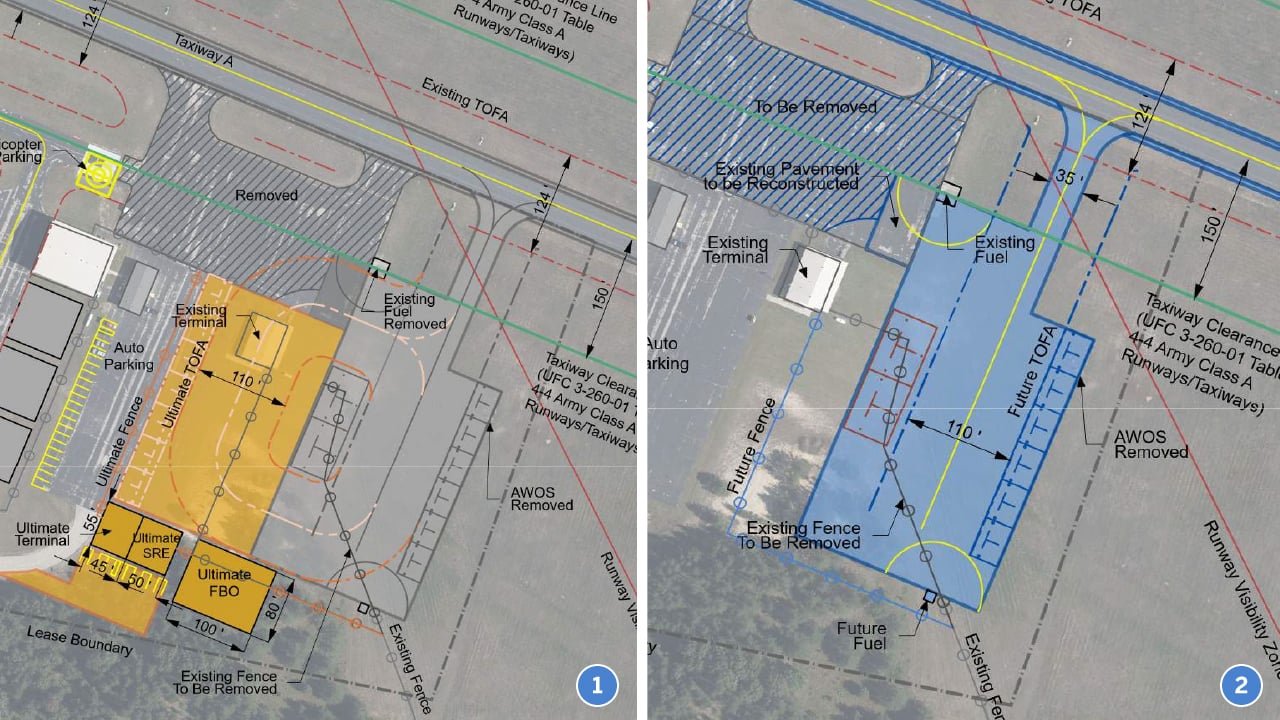 1. Graphic showing ultimate grouping tiedown areas by aircraft size and dimensions allows for maneuverability and consistency across the apron.
1. Graphic showing ultimate grouping tiedown areas by aircraft size and dimensions allows for maneuverability and consistency across the apron.
2. Graphic showing existing grouping of tiedown areas, showing limitations and functionality of existing area.
Hangar design assumptions
The demand for hangar space has increased across most general aviation facilities. Most airport sponsors or managers maintain a list of potential occupants who are searching for space to rent or build a hangar. While every airport has different hangar needs, they all understand the benefits of providing a space and location for pilots to protect and house their aircraft.
To support this growing demand, the AC update includes an expanded section on hangar design and buildings which incorporates six elements:
- Regulations and Standards – abiding by the local governing body requirements.
- Type of Hangar – conventional box, T-hangar, corporate, or even shade shelter.
- Importance of Size – type and number of aircraft plays a factor in determining width, height, depth, and number of bays provided in each hangar. These decisions drive the cost of the facility.
- Location – reducing impacts to taxilanes and aprons, along with spacing and clearance of other structures.
- Utilities – minimizing impacts to underground utilities.
- Door types – such as sliding, vertical panel, bi-fold, and fabric doors.
Providing these considerations allows for general aviation facilities to maximize space and adequately construct a hangar that will serve and provide great benefit for years to come.
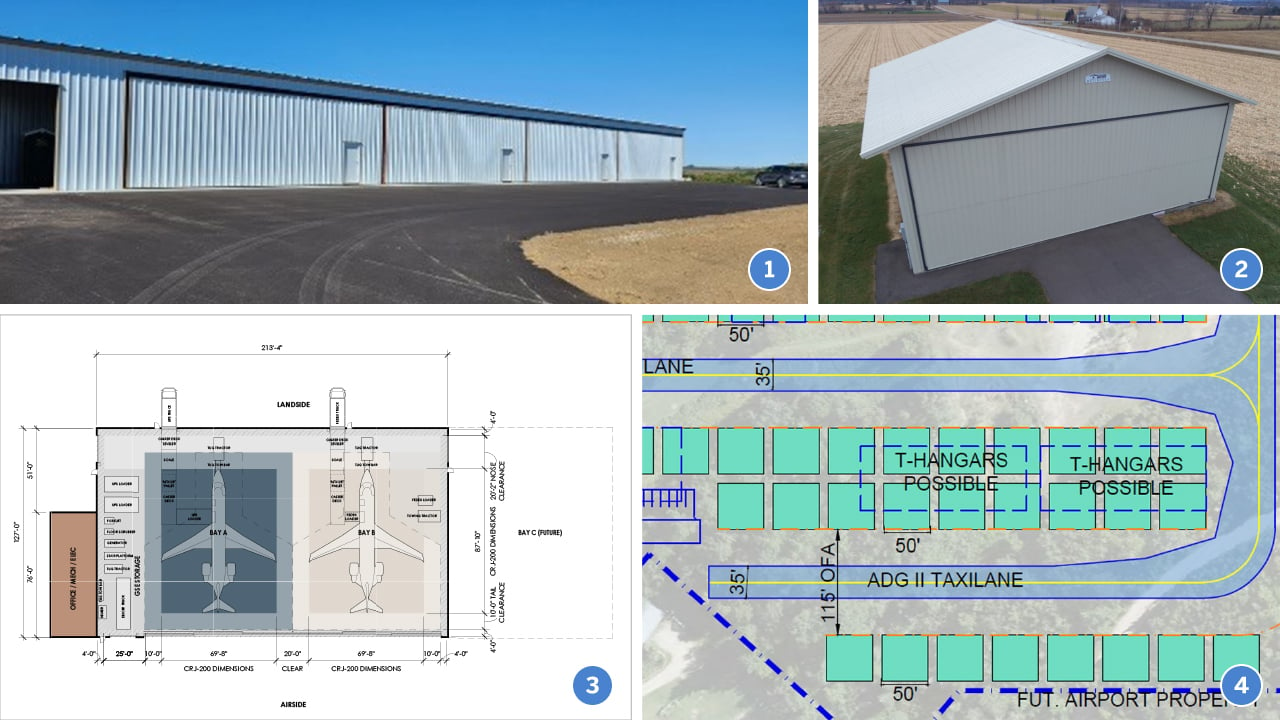 1. Example of an 8-bay T-hangar building.
1. Example of an 8-bay T-hangar building.
2. Example of a bi-fold door.
3. Graphic showing the layout and spacing of a preliminary cargo hangar.
4. Graphic showing future hangar development areas to depict space allocations.
5: Terminal Instrument Procedures (TERPS) Surfaces
Airfield and runway design must take into account Terminal Instrument Procedures (TERPS) Surfaces to protect aircraft. The updated approach and departure surfaces in the AC ensure compliance with instrument approach and departure standards, considering both on- and off-airport obstructions.
The FAA's Engineering Brief (EB) 99 and later EB 99A, along with AC 150/5300-13A, provided guidance on implementing Terminal Instrument Procedures (TERPS) surfaces and the standards needed to ensure adequate obstacle clearance on runway approach and departure procedures.
With the release of AC 150/5300-13B, several changes were made to the TERPS surfaces. New Obstacle Clearance Surfaces (OCS) were created to align with the FAA's Instrument Approach Procedures (IAP) in Job Order 8260.3E. The changes provide clear guidance on the surfaces required based on the type of runway approach procedures.
Another significant change was the relaxation of restrictions on the instrument departure surface. The creation of outer wings, or Surface 2, on the departure surface provides a steeper slope than the rest of the surface, reducing the impact near the runway thresholds.
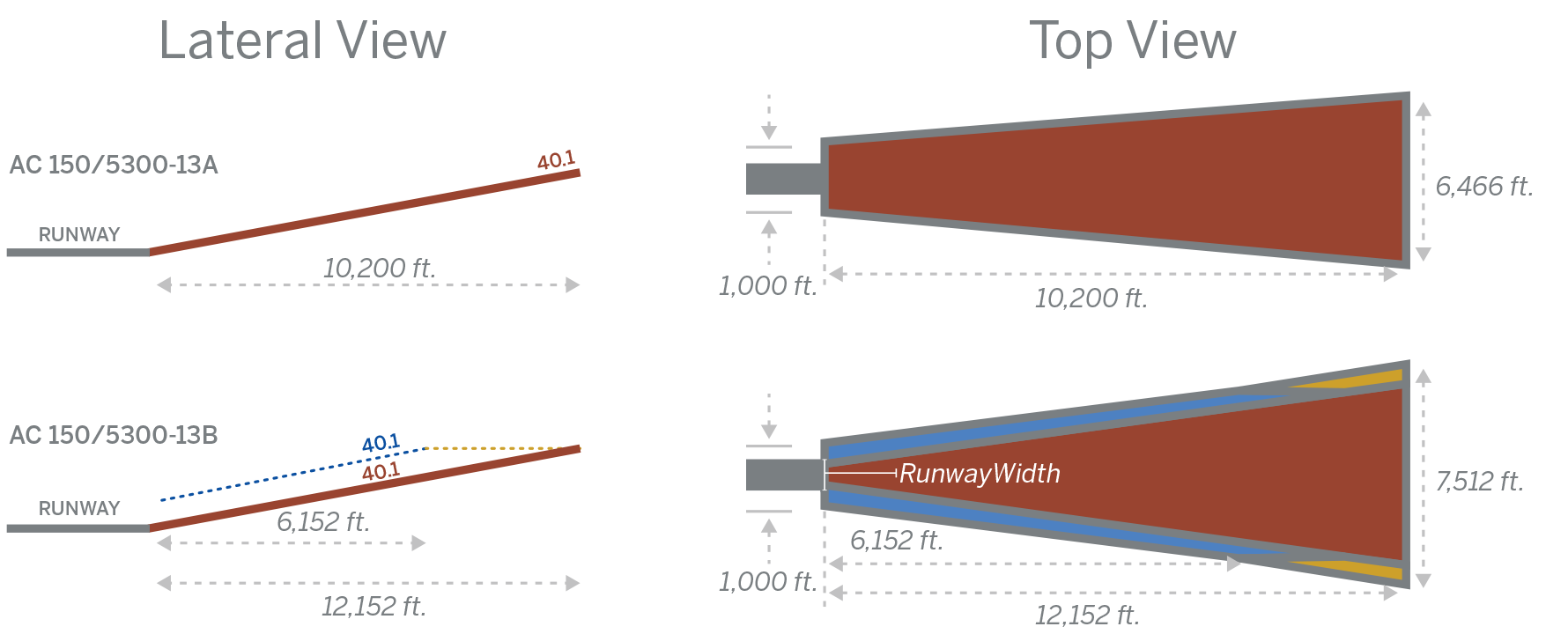
The updated AC brought welcome changes to the industry. Reevaluating old plans and engineering projects is always beneficial to validate the safety and efficiency of the airport based on the critical aircraft using the facility. With the release of updated standards, best practices, requirements, and design considerations, airport sponsors can continue to provide a facility which can be supported for many years to come.
About the Experts

Matt Stewart is an airport planner and project manager with experience in terminal operations, public and non-public areas, airfield operations, as well as airport security and badging. Matt has a vast knowledge of daily airport activities including evaluating Runway Safety Areas and ensuring FAA compliance.

Ryan Falch, PE*, is an airport engineer, project manager, and licensed drone pilot with experience managing reconstruction/rehabilitation of runways, taxiways, taxilanes, aprons, lighting systems, navigational aids, and parking lots for airports of all sizes, from commercial service to general aviation.
*Registered Professional Engineer in WI, MN, and VA

.png?width=113&name=SEH_Logo_RGB%20(1).png)
